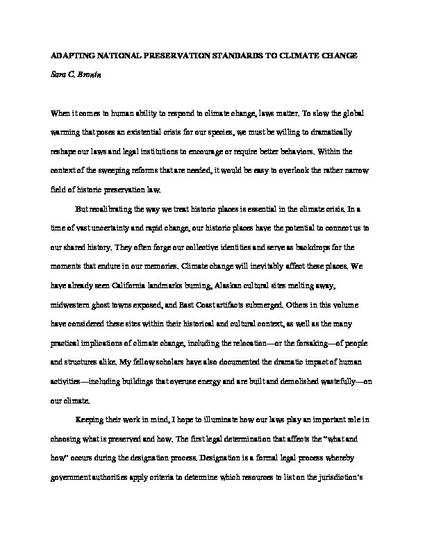
Contribution to Book
Adapting National Preservation Standards to Climate Change
Toward Sustainability and Equity: Envisioning Preservation Policy Reform
(2021)
Abstract
When it comes to human ability to respond to climate change, laws matter. To slow the warming that poses an existential crisis for our species, we must be willing to dramatically reshape our laws and legal institutions to encourage or require better behaviors. Within the context of sweeping reforms that are needed, it would be easy to overlook the rather narrow field of historic preservation law.
But recalibrating the way we treat historic places is essential in the climate crisis. In a time of vast uncertainty and rapid change, our historic places have the potential to connect us to our history. They often forge our collective identities and serve as backdrops for the moments that endure in our memories. Climate change will inevitably affect these places. We have already seen California landmarks burning, Alaskan cultural sites melting away, Midwestern ghost towns exposed, and East Coast artifacts submerged. Others have considered these sites within their historical and cultural context, and the many practical implications of climate change, including the relocation—or the forsaking—of people and structures alike.
Keeping their work in mind, I hope to illuminate how our laws play an important role in choosing what is preserved, and how. I focus on a foundational rule perhaps not-so-obviously tied to climate change: the Secretary of the Interior’s Standards for the Treatment of Historic Properties (the “Standards”). The Standards are invoked when people try to change historic properties, and they are widely accepted as the measure by which such changes should be judged. Indeed, the Standards have been adopted into law by state legislatures, tribal governments, and local historic district commissions all over the country. For that reason, what they say, and how they are interpreted, has ripple effects on preservation at every level.
In the view of many preservationists, the Standards have capably protected physical fabric within a broad interpretive framework. Unfortunately, the Standards do not adequately address climate change or reduce the environmental impact either of the people occupying historic places or of the places themselves. Instead, the Standards prohibit or make more difficult climate-related adaptations of physical form, such as installing energy-efficient windows or solar panels, raising sites, or moving structures. This essay explains the significance of the Standards, analyzes their inadequacy in the climate context, and suggests reforms that recognize the intertwined fate of our tangible heritage and our warming planet.
Keywords
- historic preservation,
- energy effficiency,
- renewable energy,
- climate change,
- flooding,
- heritage,
- global warming,
- property law
Disciplines
Publication Date
2021
Editor
Erica Avrami
Publisher
Columbia University Press
Citation Information
Sara C Bronin. "Adapting National Preservation Standards to Climate Change" Toward Sustainability and Equity: Envisioning Preservation Policy Reform (2021) Available at: http://works.bepress.com/bronin/45/
